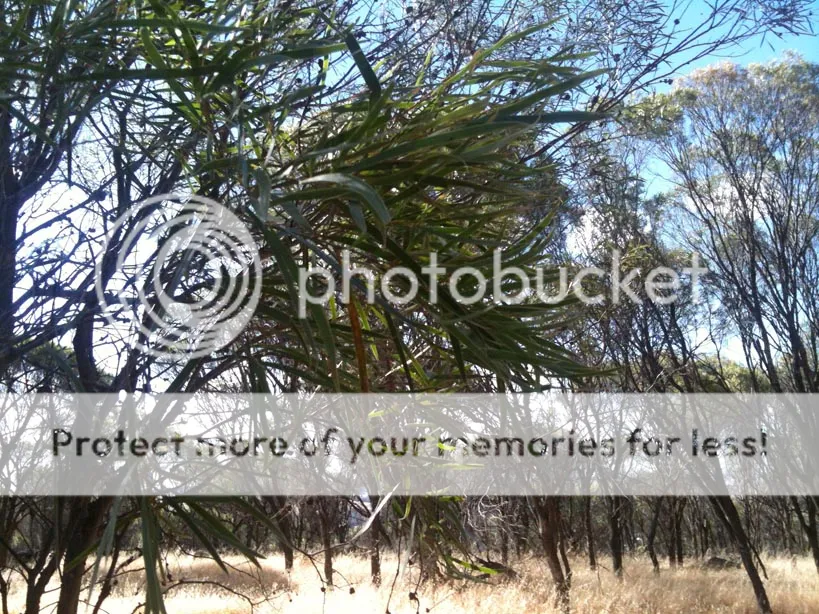member for the trees
  
Posts: 4003 Joined: 28-Jun-2011 Last visit: 27-May-2024
|
..thanks for pics and nice to hear from africa xantho..  ..yeah the slight 'hookiness' of the thorns, and location, suggest A. caffra (Cat-Thorn) ..there are no known tests for alkaloids..i noticed while browsing: "Black rhino browse and eat the stem and bark, and baboons eat flowers and seed (Timberlake et al. 1999, Wickens et al. 1995). An important honey source in southern Africa. The Zulus use a bark infusion for blood disorders." ..worth investigating..there should also be a few known tryptamine species on the ground in your region xantho..! EDIT: i just found this: Quote:Acacia caffra contained alkaloids, polyphenols, flavones, tannins, steroids, saponins and glycosides. Its petroleum extract had a retention factor of 0.17, 0.29, 0.39, 0.50, 0.63 and 0.75 in benzene. ["Chemical Pprofiles Of Five Swazi Medicinal Plants" by O. O. G. Amusan]..really should go in the acacia info thread, but A. caffra's not in there yet..! i'll add this as a link in it's index.. EDIT 2: ps. shaneduddy2..that does look like A. cyclops above..see, plenty to look at near you.. 
|
|
|
|
|

DMT-Nexus member
Posts: 2229 Joined: 22-Jul-2011 Last visit: 02-May-2024 Location: in the underbelly of the cosmic womb
|
nice xantho look forward to hearing your results.. its good to have another keen researcher on board. and yeah the acacia has a way of drawing people in. it is a true teacher. see ya round 
|
|
|

DMT-Nexus member
Posts: 190 Joined: 19-Jan-2012 Last visit: 26-May-2017
|
Thanks for the great info and support nen and acacian! Your immense knowledge, curiosity, and enthusiasm is very infectious and I know I am far-from-alone in voicing my appreciation of your efforts.  The guide book I am using also mentions that the leaves of A. caffra are chewed for stomach ache. Thankfully I have lots of plant material to work with so I'll kick-off the first experiment in the coming weeks and see how things progress. I get the feeling that I'm positively surrounded by various Acacia species, both indigenous and introduced/naturalized (A. mearnsii and many other Australian species). A. karroo and A. xanthophloea are also common in my area so the tryptamines are most definitely on the scene  . I'll keep you posted on my activities  "Becoming a person of the plants is not a learning process, it is a remembering process. Somewhere in our ancestral line, there was someone that lived deeply connected to the Earth, the Elements, the Sun, Moon and Stars. That ancestor lives inside our DNA, dormant, unexpressed, waiting to be remembered and brought back to life to show us the true nature of our indigenous soul" - Sajah Popham.
|
|
|
DMT-Nexus member
Posts: 1 Joined: 10-Nov-2012 Last visit: 11-Nov-2012 Location: Oz
|
Hi all, wonderful resource you have all contributed to here. I went on a quest for a friend Acacia Acuminata today, in the Avon region of WA. I think I had a little luck, but I'm not sure - all the pics I've seen of it flowering. If I'm not mistaken, it's just outside the season for that.    I don't *think* I've just taken a photo of some gumtree but that's a very real danger. 
|
|
|

DMT-Nexus member
Posts: 131 Joined: 06-Nov-2012 Last visit: 04-Oct-2014 Location: Hyperborea
|
That does look the acuminata from the leaf tip curl. But in the acacia info thread they say there are lookalikes, which is why flowers is important.
|
|
|
DMT-Nexus member
Posts: 5 Joined: 22-Oct-2012 Last visit: 03-Jul-2013 Location: Falling endlessly through the void
|
Is this acacia mearnsii or black wattle like I suspect it is? It seems to fit all the criteria including the strong perfume emanating from the flower.  
|
|
|

DMT-Nexus member
Posts: 103 Joined: 29-Oct-2012 Last visit: 14-Jan-2014 Location: Paris, Texas
|
Yes Stoner Caravan. I would say that's A. mearnsii. There's detailed description in the acacia info thread somewhere if you search the index. A close up of the pinnae, or small leaves, is probably what a botanist would ask for. But I'd say that's it. The flowers do smell Beautiful. What part of the world is this beauty btw?
|
|
|
DMT-Nexus member
Posts: 5 Joined: 22-Oct-2012 Last visit: 03-Jul-2013 Location: Falling endlessly through the void
|
phyllode wrote:Yes Stoner Caravan. I would say that's A. mearnsii. There's detailed description in the acacia info thread somewhere if you search the index. A close up of the pinnae, or small leaves, is probably what a botanist would ask for. But I'd say that's it. The flowers do smell Beautiful. What part of the world is this beauty btw? Marvellous! Indeed they do. Victoria, Australia. I am capable of my own research regarding theoretical extraction but a helping hand would not go amiss! Thanks for the quick response.
|
|
|
member for the trees
  
Posts: 4003 Joined: 28-Jun-2011 Last visit: 27-May-2024
|
Hey Stoner! Hope you don't vanish off in your Caravan without telling us how your test extraction went..  Yeah, looks like mearnsii. On page 42 (#831) of the acacia info thread is a pic posted by phyllode bless her of acacia phyllode and leaf definition..the drawing shows what 'jugary glands' and 'inter-jugary' glands are. A. mearnsii will have either one or both of these. Botanical drawing of it on p.41 (i think!) ........................................... ps. be careful not to confuse some southern australian forms of A. melanoxylon with A. cyclops..check the pods and arils carefully..and the nerve characteristics of the phyllodes..the www map of A. cyclops range does not reflect that it is 'naturalised' in a lot of north western W.A..also naturalised in South Africa and the Canary Islands..
|
|
|
DMT-Nexus member
Posts: 5 Joined: 22-Oct-2012 Last visit: 03-Jul-2013 Location: Falling endlessly through the void
|
nen888 wrote:Hey Stoner! Hope you don't vanish off in your Caravan without telling us how your test extraction went..  Yeah, looks like mearnsii. On page 42 (#831) of the acacia info thread is a pic posted by phyllode bless her of acacia phyllode and leaf definition..the drawing shows what 'jugary glands' and 'inter-jugary' glands are. A. mearnsii will have either one or both of these. Botanical drawing of it on p.41 (i think!) ........................................... ps. be careful not to confuse some southern australian forms of A. melanoxylon with A. cyclops..check the pods and arils carefully..and the nerve characteristics of the phyllodes..the www map of A. cyclops range does not reflect that it is 'naturalised' in a lot of north western W.A..also naturalised in South Africa and the Canary Islands.. Indeed. I've been reading about the phyllode extraction, but I've read that the active alkaloids are mainly in the bark. Perhaps you could point me in the direction of a suitable tek?
|
|
|

DMT-Nexus member
Posts: 103 Joined: 29-Oct-2012 Last visit: 14-Jan-2014 Location: Paris, Texas
|
^Nen often suggests twigs or branch for bark. Not trunk as this cause dieback in tree.
|
|
|
Dave
Posts: 43 Joined: 05-Dec-2011 Last visit: 09-Nov-2013 Location: Live Music Capital of the World Texas USA
|
I today went looking for the tried and tested prarie bundle flower and found none near the old distribution collection point due to urban growth. However to my suprise I found what appears to be Acacia Rigidula it has the rounded pinnate leaves straight thorns and often displays characteristic double antler thorns' I have found these straight double antler thorns also in the Acacia Farnesiana Tree as well, the leaves of Farnesiana are very small. It is interesting that thorns although good identifiers in Acacias can vary widely depending on age size and season. They may be present or not single or double but are most prevalent in well established young plants, that are trying to resist browsing. Flowers are often the best identifier but I am out of season. My concerns on identification are the bottlenecked seedpods that usually have 3 seeds in them and the number of phylodes the ones I harvested are seemingly in about 15 pairs and the examples as seen here by usda, npin and wildflower center seem to have about 4 pairs. Here are some examples to compare assuming they are correct: http://www.wildflower.or...esult.php?id_image=21085fractalicious attached the following image(s):  RIGIDULA 004.JPG (3,017kb) downloaded 211 time(s). RIGIDULA 006.JPG (3,143kb) downloaded 209 time(s). RIGIDULA 008.JPG (2,954kb) downloaded 209 time(s). RIGIDULA 011.JPG (3,099kb) downloaded 208 time(s). Rigidula Pods 002.JPG (2,948kb) downloaded 204 time(s). Rigidula Pods 003.JPG (2,893kb) downloaded 200 time(s).The difficulty of performing a given task is directly proportional to a persons capability for confusion![color=red]
|
|
|

DMT-Nexus member
Posts: 103 Joined: 29-Oct-2012 Last visit: 14-Jan-2014 Location: Paris, Texas
|
That looks like rigidula. Have you got pics of flowers, and maybe a close-up of the pinnae (leaves) ?
|
|
|

DMT-Nexus member
Posts: 190 Joined: 19-Jan-2012 Last visit: 26-May-2017
|
I finally got around to taking some photos of trees I see on my daily bus journeys that look like they could be acacias or mimosas. Any identification assistance from my acacian wizard friends would be greatly appreciated!  The first photo is of a small tree on campus. Paired thorns at the nodes though not white like a few other African species I'm familiar with (I tried identifying this one from a book a while ago but had no joy). Could be naturalized from elsewhere? I'll take more photos of it next time. Second photo: Gall city! Aussie species?  No flowers or seeds at the moment. Photos three and four are of a lovely lady I've had my eye on for a while (she was flowering a couple months ago - otherwise I might never have noticed her). I believe they were spherical and whiteish flowers. Another Aussie? And one more, photo five, seed pod on a tree in a separate location. xantho attached the following image(s):  P1000718edit.JPG (1,541kb) downloaded 273 time(s). P1000727edit.JPG (1,303kb) downloaded 270 time(s). P1000729edit.JPG (389kb) downloaded 267 time(s). P1000732edit.JPG (1,515kb) downloaded 268 time(s). P1000741edit.JPG (1,284kb) downloaded 268 time(s)."Becoming a person of the plants is not a learning process, it is a remembering process. Somewhere in our ancestral line, there was someone that lived deeply connected to the Earth, the Elements, the Sun, Moon and Stars. That ancestor lives inside our DNA, dormant, unexpressed, waiting to be remembered and brought back to life to show us the true nature of our indigenous soul" - Sajah Popham.
|
|
|

DMT-Nexus member
Posts: 2229 Joined: 22-Jul-2011 Last visit: 02-May-2024 Location: in the underbelly of the cosmic womb
|
Hey Xantho! Thanks for your explorations.. I'm sorry to say I cannot be of too much help on the first three photos, however the last looks like an australian species, Acacia Saligna - which has actually become prolific in south africa. the 2nd last one looks a lot like acacia longifolia.. but I'm not so sure.. nen is the man for the job here I though think  keep up the good work  ... the first photo is stunning by the way
|
|
|
member for the trees
  
Posts: 4003 Joined: 28-Jun-2011 Last visit: 27-May-2024
|
..yeah, likewise, keep up the great work xantho..  pic 1) & 3) look like Mimosa pigra ('Giant Sensitive Tree'  ), a weed in africa, india and australia.. not sure about ethnobotanic use/compounds yet..haven't had a chance to serach.. pic 2) looks like Acacia cyclops..which of course Primal Wisdom achieved good results with one one occasion in Sth Africa early in the info thread, and dromedary in australia a short whie later.. scarlet arils on the seeds in pods is the key.. and the last is as acacian says like A. saligna..for a good comparison of saligna and close relatives see here in question about my acacia spice.. . Mimosa pigra below: nen888 attached the following image(s):  mimosa_tree(1).jpg (54kb) downloaded 253 time(s). mimosa pigra pic2.jpg (54kb) downloaded 243 time(s).
|
|
|

DMT-Nexus member
Posts: 190 Joined: 19-Jan-2012 Last visit: 26-May-2017
|
Thanks acacian and nen! It's always lovely to sit down at the computer after my morning coffee and receive your transmissions of knowledge and encouragement. I think we're on target with the A. cyclops and A. saligna (I'll spend some more time in conversation with them) but I'm unsure whether the tree depicted in the 3rd and 4th photos is M. pigra. The seed pods of pigra seem to have many more segments than those I found. I'll open up some of the pods I collected from the ground around the tree and see if I can get any further with a solid ID. So far as ethnobotanical uses of M. pigra go, a quick search provided the following: Uses for Mimosa pigra - I.L. MillerQuote:Claims have been made that the roots are sniffed for head colds, a decoction of the leafy stem is used as a mouthwash for toothaches, and that the fruits are used in eye medicines (Anon. 1980). Apparently it is also used for the treatment of snakebite in Africa (Irvine 1961). In Sumatra, roasted and ground mimosa leaves are made into an infusion, which is drunk to treat a weak heart or weak pulse (Grosvenor et al. 1995). A decoction of dried and ground male and female parts is used in the same manner. In Mexico, an infusion of mimosa was traditionally used in Mayan medicine for treatment of diarrhoea. This knowledge led to leaves of mimosa and other legumes being phytochemically screened and tested for antimicrobial activity (Rosado-Vallado et al. 2000). In phytochemical screening, flavonoides, quinones, saponins, sterols and tannins were detected in mimosa. Extracts of mimosa showed antimicrobial activity against four bacteria, Staphylococcus aureus, Bacillus subtilis, Pseudomonas aeruginosa and Candida albicans, but not Escherichia coli. It was concluded that the use of mimosa, and the other legumes tested could not be justified for treating diarrhoea. However, the level of antibacterial activity shown could support the use of mimosa in treating infected wounds and eye and skin infections. Further general information can be found in the Mimosa Weed Management Guide. I need to make a couple friends in the botany department, hmmm... Be well my friends and thanks again for the help!  "Becoming a person of the plants is not a learning process, it is a remembering process. Somewhere in our ancestral line, there was someone that lived deeply connected to the Earth, the Elements, the Sun, Moon and Stars. That ancestor lives inside our DNA, dormant, unexpressed, waiting to be remembered and brought back to life to show us the true nature of our indigenous soul" - Sajah Popham.
|
|
|
member for the trees
  
Posts: 4003 Joined: 28-Jun-2011 Last visit: 27-May-2024
|
^..hey thanks for the research xantho!  ..and you're sharp..i did notice the pods weren't quite right, but not being an expert on african mimosas i thought i good to start somewhere..it's really interesting, whatever it is..i'll keep sifting through the info-plains..
|
|
|
member for the trees
  
Posts: 4003 Joined: 28-Jun-2011 Last visit: 27-May-2024
|
..you know xantho, the pods of that 'mimosa' are quite acacian.. 
|
|
|

DMT-Nexus member
Posts: 190 Joined: 19-Jan-2012 Last visit: 26-May-2017
|
The nen nose knows  It is definitely on my list for further investigation. I've been trawling the interwebz for a little while now, trying to get a better handle on the ID (or at least eliminate a few possibles). Here's what I'm working with (from a list of Mimosas in southern Africa): M. pigra, M. pudica, M. acanthocarpa, M. biuncifera, M. bracaatinga, M. latispinosa, M. lindheimeri, M. polycarpa, M. rubricaulis, M. spegazzinii. I have to get back to my other research obligations for now but I'll be back whenever possible to update the list and whittle down (see what I did there?  ) the possibilities. Hey you lurkers! Come out and play  Interaction is far more fun that absorption. "Becoming a person of the plants is not a learning process, it is a remembering process. Somewhere in our ancestral line, there was someone that lived deeply connected to the Earth, the Elements, the Sun, Moon and Stars. That ancestor lives inside our DNA, dormant, unexpressed, waiting to be remembered and brought back to life to show us the true nature of our indigenous soul" - Sajah Popham.
|